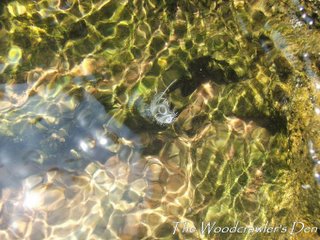
If only we could rewind and edit our lives ...... The jungle brings serenity. It recharges the batteries and it teaches you how uncomplicated life can be. In my life's moments if there is something to cherish, it is the time I have spent woodcrawling. Try it and you'll know what I mean.
Sunday, February 26, 2006
Do jellyfish sting?

Wednesday, February 22, 2006
Gangaswamy and the Tale of two Resorts - Part 2

Come February, its celebration for yours truly. The wedding anniversary is an excuse for spending time with two people who make life meaningful, my wife and son, Shruthi and Skanda. We decided to go on the quest for Gangaswamy. It’s a long drive from Palakkad through
The resort is located on the east bank of the Bhadra reservoir on a small hillock overlooking the expansive body of water. They have ten cottages now. I decline to call them log huts. Unlike BRT this is a predominantly cement and concrete structure with electricity and hot water. Of course no TV, thank God.
If you are looking for wildlife you will be disappointed. It’s not to say that wildlife is absent, we saw fresh tiger pugmarks. This patch of green is part of the Bhadra Tiger Reserve and has not been developed with the tourist in mind. The jungle is dense with the undergrowth predominated by bamboo. Wildlife is invisible. The trees here are more massive and so good light for photography is a premium.
The ‘tourist’ zone has few waterholes, probably because of the reservoir close by. The salt licks are just being developed and animals need to learn that they are supposed to congregate there to entertain the two-legged visitors. You have a better chance to spot wildlife on the boat trip in the evening. Even the crocs come to bask then.
If you like water and don’t fear its murky depths you have plenty to do. You can go kayaking, water-trampolining or simply swimming around. It’s a different issue that my son’s initial enthusiasm got dampened after a soak in the cold water!
Then there was Gangaswamy. You don’t need TV or music. If he likes you he can overwhelm you with his non-stop flow of words. Athirapally or Shivasamudram will be some minor cascades! He can keep you entertained all day. One unique characteristic is that he is very effusive in his ‘encouragement’ of his subordinates. He has them jumping. You can see the difference in BRT after his departure. He told me some forest land was being put on offer in Bhadra. Maybe I should consider it. Bhadra seems to be a place where Woodcrawlers can retire to!
Wednesday, February 15, 2006
Gangaswamy and the Tale of two Resorts - Part 1

PART - 1
Gangaswamy is an enigma. Love him or hate him he has this habit of permeating the environment he is in. He comes out either as an obnoxious personality or someone down-to-earth. I first encountered him in 2001 as a part of my New Year celebration. He was the Resort-in-charge at BRT Camp of JLR then. This resort was the not very well known and was a perfect getaway. I believe Gangaswamy has had a large role to play in its development. More of that later but may his tribe increase.
Christmas of 2005 saw us on our second visit to BRT camp (Biligiri Ranganbetta, for the uninitiated). A little known hilltop jungle till recently, it has some of the richest density of wildlife mainly gaur and elephants. We were on our second visit and were looking forward to another amusing adventure with Gangaswamy. However, when we got there, no Gangaswamy. Poor man was shunted some 400 kms north to ‘develop’ JLR’s new resort at Bhadra.
BRT, to me ranks third after Nagarhole and Bandipur for wildlife. If you are not obsessed with the tiger and will manage with an occasional bear or leopard, this is the place to be in. They have some excellent tented accommodation and log huts. No electricity, No TV, and 100% peace of mind. The present incumbent Sourav unlike Gangaswamy is an introvert and prefers to spend time listening to music. He takes time to warm up and speaks only when spoken to. You almost never realize he is around.
Forty eight hours saw us sighting sloth bears, barking deer, gaur, elephants and countless deer. No tiger, no leopard. We are getting used to that. In any case we were there to soak the atmosphere and make new friends. When it was time to go I thought the trip was incomplete without Gangaswamy.
BRT seemed less lively without him and therein lies the reason for a trip 400 km northward......................